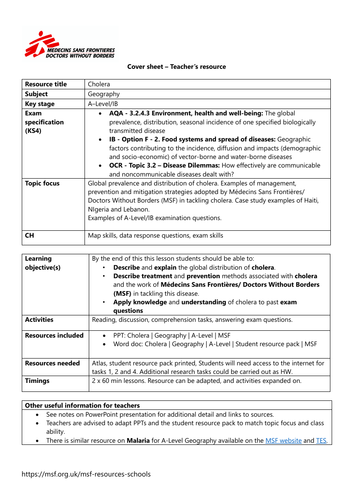



This detailed resource for students of A-Level Geography examines the global prevalence and distribution of cholera. It provides examples of cholera outbreaks in Haiti, Nigeria and Lebanon. The resource discusses examples of management, prevention and mitigation strategies adopted by Médecins Sans Frontières/ Doctors Without Borders (MSF) in tackling cholera. There are a range of activities with answers and examples of A-Level/IB examination questions in the presentation for students to work through.
Specification links
- AQA - 3.2.4.3 Environment, health and well-being - The global prevalence, distribution, seasonal incidence of one specified biologically transmitted disease, e.g. malaria; its links to physical and socio-economic environments including impacts of environmental variables on transmission vectors. Impact on health and well-being. Management and mitigation strategies.
- IB - Option F - 2. Food systems and spread of diseases - Geographic factors contributing to the incidence, diffusion and impacts (demographic and socio-economic) of vector-borne and water-borne diseases - One detailed example of a vector-borne disease and one detailed example of a water-borne disease
- OCR - Topic 3.2 – Disease Dilemmas - 3. How effectively are communicable and noncommunicable diseases dealt with? - Case study of one communicable disease, such as malaria or tuberculosis, at a country scale, either an LIDC or EDC, including: environmental and human causes of the disease/ prevalence, incidence and patterns of the disease / socio-economic impacts of the disease/ direct and indirect strategies used by government and international agencies to mitigate against the disease and respond to outbreaks.
Something went wrong, please try again later.
This resource hasn't been reviewed yet
To ensure quality for our reviews, only customers who have downloaded this resource can review it
Report this resourceto let us know if it violates our terms and conditions.
Our customer service team will review your report and will be in touch.